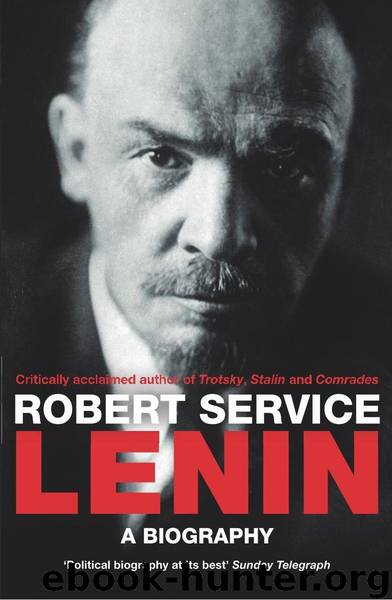Lenin: A Biography by Robert Service

Author:Robert Service [Service, Robert]
Language: eng
Format: epub
ISBN: 9780330476331
Publisher: Pan Macmillan
Published: 2011-02-20T23:00:00+00:00
No Alpine air. No vigorous striding up mountain paths. No trips on his bicycle. Just a quick little stroll around the block from Broad Street.
But increasingly Lenin could leave important party functions to others in the Bolshevik Central Committee. Sverdlov was a brilliant administrator in the Secretariat. Kamenev did regular work in the Petrograd Soviet. Stalin was adept at handling most jobs given to him. Zinoviev was a captivating orator. The party also started to attract other Marxists who had previously not accepted Bolshevism. One such was Felix Dzierżyński, a Polish leader who had worked closely with Rosa Luxemburg. But perhaps the most surprising new Bolshevik adherent was none other than Trotski. Lenin courted him once Trotski had made his way back from North America in May 1917. For his part Trotski thought Lenin’s decision to go for immediate socialist revolution to be a tacit espousal of Trotskyism. Trotski was therefore keen to enter the only large party that was unconditionally hostile to the Provisional Government: he gave up entirely on the Mensheviks. But years of vituperation between Trotski and the Bolshevik faction were not easily expunged from the minds of other leading Bolsheviks, and Lenin had his work cut out persuading his less calculating comrades to welcome the dazzling literary, oratorical and organisational skills of their former enemy. But Lenin succeeded, and Trotski joined.
It was as well for Lenin that he could depend on such a team since there were limits to his influence inside and outside his party. Few people knew what he looked like. Contemporary Russian newspapers carried no pictures of him; and unlike Alexander Kerenski, the real master of the modern technology of politics in 1917, Lenin had no opportunity to have newsreels taken of him. Moreover, Pravda was a dour newspaper and commissioned no cartoons of him, and posters of Lenin were not made until after the October Revolution. Contrary to the conventional impression about them, the propaganda techniques of the Bolsheviks in 1917 were not very imaginative, and it was the newspapers of the other political trends that pioneered pictorial representation. Even so, such newspapers did not popularise Lenin’s image with anything near to accuracy. For example, the caricaturists in the Kadet newspaper Rech portrayed him as a great bear of a man rather than the squat, stocky fellow that he was – and, as often as not, without his moustache and with more hair than he had since his early twenties.
Lenin did not stray from Petrograd on political campaigns; he turned down every invitation to visit the rest of Russia after his long journey from Zurich. What he knew about the country came through visitors to Petrograd and from the newspapers. There was obvious irony in this. He was credited by the Provisional Government and the anti-Bolshevik parties with almost miraculous power (and this reputation has not vanished in our day). Yet the Bolshevik party was not the well-oiled machine of command that would have made this possible. Its committees in the provinces were reluctant automatically to toe the line drawn by the Central Committee.
Download
This site does not store any files on its server. We only index and link to content provided by other sites. Please contact the content providers to delete copyright contents if any and email us, we'll remove relevant links or contents immediately.
Blood and Oil by Bradley Hope(1246)
Daniel Holmes: A Memoir From Malta's Prison: From a cage, on a rock, in a puddle... by Daniel Holmes(1117)
Ambition and Desire: The Dangerous Life of Josephine Bonaparte by Kate Williams(1084)
Wandering in Strange Lands by Morgan Jerkins(1014)
It Was All a Lie by Stuart Stevens;(939)
What Really Happened: The Death of Hitler by Robert J. Hutchinson(867)
London in the Twentieth Century by Jerry White(844)
Time of the Magicians by Wolfram Eilenberger(842)
The First Conspiracy by Brad Meltzer & Josh Mensch(811)
Twilight of the Gods by Ian W. Toll(810)
A Woman by Sibilla Aleramo(796)
The Japanese by Christopher Harding(795)
Lenin: A Biography by Robert Service(777)
The Devil You Know by Charles M. Blow(777)
Reading for Life by Philip Davis(774)
Cleopatra by Alberto Angela(764)
Twelve Caesars by Mary Beard(764)
1965--The Most Revolutionary Year in Music by Andrew Grant Jackson(714)
The Life of William Faulkner by Carl Rollyson(713)
